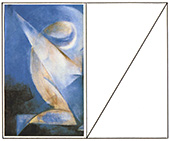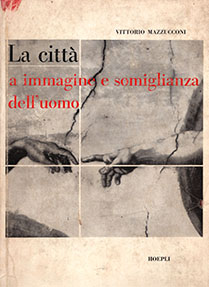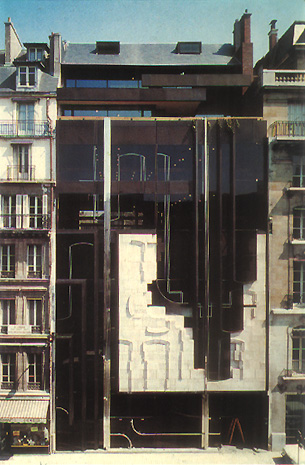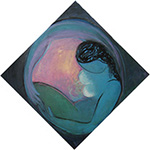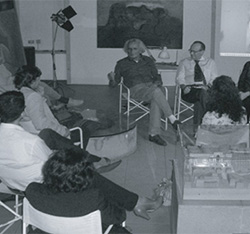Biography
1929
Vittorio Mazzucconi was born on 18 June 1929 in Grosseto, from a Florentine family, in the sign of Gemini, with an ascendant Libra. His father, Ridolfo, was a journalist and writer. His mother, Evelina, was the sister of the painter Silvio Pucci: to this family of artists will add Fioretta, painter, and his son Marco, conceptual artist.
But there is in him a deeper bond than the familiar ones: it is the one with the roots in ancient Etruria and in the Florentine Renaissance, with which he feels a continuity that leads him to proposing its new flowering with “The dawning City" project for a new center of Florence.
Preparation
In the years of childhood, family events took him from Florence to Milan and other cities, with continuous movements, in one way or another.
He then followed classical and artistic studies. Since his first inclination was towards painting, his father, as a good Florentine, demanded that he devote himself first to drawing, so as to become a "great draftsman", as it is in the Tuscan tradition. So many countless drawings of nude, anatomy, drapery, flowers and leaves, perspective studies, geometries, etc. have been left of this preparation, as was done in the golden age of Italian art. Next to the drawing and to a real "sublimation of geometry” ( 1 ), as Agnoldomenico Pica says , the boy studied letters, feeding on the books of his father's library, mostly of the classics, and above all, in the true sense of the word, of Dante.
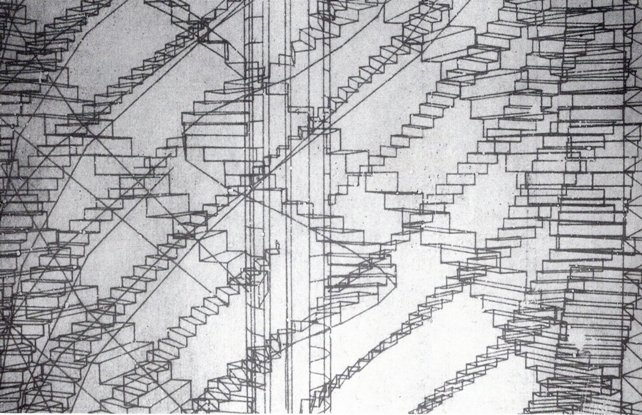
Perspective study
1946
Mazzucconi remembers his stay in Florence this year, when his love for the city, for his churches and museums, made him feel a feverish desire to learn, devoting himself completely to drawing. "Masaccio and Brunelleschi were my masters - he tells us - it was as if, with them and with the other great ones, I relived the Renaissance".
1947-52
The next and final transfer to Lombardy, first in a town near Busto Arsizio and then in Milan, had to do with the young artist the effect that has a frost for a plant in full bloom. "Instead of the works of the Renaissance and the hills of Florence, I contemplated and sadly drew the high-tension pylons of the foggy plain ... ". It is a fact that love for art was blocked, frozen for years, except for a more rational art like architecture, to which Mazzucconi began to apply.
He nevertheless did’nt succede in attending the Polytechnic, whose teaching was no less boring and abstract to him than the pylons of the Lombard plain. He decided to take the difficult path of solitary learning, off the beaten path and the same legal possibility of practicing the profession. But he was in good company along this path: besides his dear masters of the past who were certainly not graduates, Le Corbusier, Wright and Mies van der Rohe, which had not followed a different one.
1953-56
The beginnings
After years of difficult orientation, his meeting with Carlo Bruno Negri, who had been a pupil of the great Muzio, was a providential one. He was not only an architect with competence and honesty, but a poet. He taught the young man to build, keeping his feet close to reality, but loving and always following beauty and truth. In addition to work in his office, Mazzucconi dedicated himself to his first, "exhausting" projects in the evenings.
While the first, that of Bari, shows the theoretical, almost metaphysical, abstractness of Mazzucconi's previous preparation, the others are instead the result of the real graft of constructive competence learned in Negri's office, not without some stylistic references to his work.
In the perspective views of these projects, the fantastic character of their settings is astonishing, without any reference to the real context, and this in an architect who would later prove extremely attentive to the places in which to insert his projects. It is as if he were drawing the places of the soul before looking at the real ones, thus preparing the attitude to interpret these also in a poetic way.
Projects:
1956
Switzerland
He began his long period of stay abroad, where he would work and study for seven years, anticipating the Erasmus program that many young people would start to follow thirty-five years later. He began with neighboring Switzerland, working in Neuchatel and Lausanne in the office of architect J.Tschumi , with whom he worked for the facades of the Nestlé building in Vevey.
After a couple of years he went to Sweden, his girlfriend's country and then, finally, to Paris.
1958-61
Paris
The long stay in Paris was fundamental for the young Mazzucconi as for many other artists: as a cultural awareness (in a sense his self-taught education had left him at the Renaissance while, in Paris, it was all European culture until his splendid Eight-twentieth century to enter his soul), as an initiation into modern architecture, also with the meeting with Le Corbusier, as a basis for the real professional activity that he would have done in Paris many years later.
In Paris he marries May and works in some not big-name offices that allow him to do a direct design experience and develop his own language. Certain of his projects of this period brought a new air into an architecture like the French one, close then between the academy and rationalism, but they were not realized.
Projects:
- Offices and Warehouse in Jennevillers
- Maison de la Jeunesse and School-Convent of nuns in Paris
- Condominium in Bourg la Rejne
1961-62
London
From the culture of ideas to that of pragmatism, from big projects to small details, the preparation of the young was completed by such a jump. He was also tempered, similarly, on a different level, to what he had experienced many years before in the abrupt transition from Florence to Milan. In addition to his work in the London County Council's Department of Architecture, he spent the evening on projects for competitions.
Projects:
-
Competition for a Church in Denmark
- Competition for the Peugeot Skyscraper in Buenos Aires
1962-66
Val Padana
After another attempt to settle in Sweden, Mazzucconi finally returns to Milan, which he had left seven years earlier, and finally sets up on his own. Office and home together, the birth of the first child, Marco, the first works build in the middle of the suburbs of Milan. He dreamed and realized buildings inspired by the landscape of the Po Valley and its traditions, fighting against degradation and against the prevailing architectural ideology itself. He was the first to rediscover the meaning and beauty of the roofs, designing buildings brought back to a more human scale and rooted in regional culture.
In living the difficult relationship between love for this culture and the urgency of modernity, Mazzucconi went much further than these first proposals, developing in a book a new approach to rethink the whole city and its region.
Projects:
1967
The City in Image and Likeness of Man
His first book is published: "The City in Image and Likeness of Man" , with the Hoepli Editions. In its first part, it deals with a long reflection on the crisis of civilization and the city, to the point of overshadowing the conception of an ideal city. In the second, this idea, like a soul, is embodied in the body of a true city, Milan, and transforms it profoundly.
Such radical ideality was certainly at the antipodes of the small world of ordinary reality, made up of narrow ideas, interests and political malpractice. When Mazzucconi, absorbed by his vision, finally became aware of its distance from reality, he was so shaken by the disillusion that he had to decide, as soon as the book was published, to leave Milan once again.
Fifty years later, what can we say about this book? On a general level, it was among the first to announce the prospect of an apocalypse of our time and its possible catharsis. As for the urban plan proposed by the book, is it just a utopia? Instead it is a completely realistic project, while the only utopia would be to think that it can be realized in the current political, administrative and cultural conditions, apart from some aspects that have actually been realized and that the project anticipated: the idea of the big metropolitan area, the progressive reduction of traffic in the historic center, the explosion of skyscrapers, the transformation of the area of the Fair, the reopening of the Navigli, greater protection and awareness of cultural heritage and green areas.
Projects:
- Urban Plan of Milan and its region, project for a skyscraper in the Fiera area, Milan
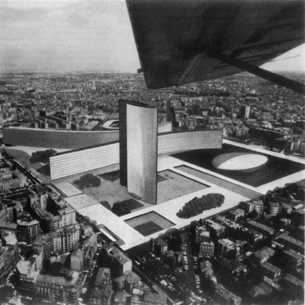
Overall view, Milan plan (detail)
1967-68
In America, at Cambridge Mass. The relationship between rationality and the brilliant technology of the skyscrapers, on the one hand, and the organicity, almost the romanticism of the houses and the garden-cities on the other, that Mazzucconi had dreamed of in his plan of Milan, they were here under his eyes. America seemed to be more congenial than any other country, but unfortunately it was so difficult to enter and restart the routine and collaboration in other offices. So, despite the prospects that could offer him an office such as The TAC of Walter Gropius, with whom he worked, Mazzucconi chose the return in his "modest white room" in Milan, where he could perhaps be poor and disappointed, but still with the full resources of his creativity and independence.
1968-70
La Fornace degli Angioli
Back in Milan, he immersed himself in the project of a very particular house, all based on an inner need for orientation. Besides this, the field of interior architecture gave him many satisfactions, also economic, very welcome after so many difficulties .
In 1969 Giovanna was born. As the family was therefore growing and the home was becoming narrower, he should look for an office outside, which he found in the same year and inaugurated in 1970: it was "La Fornace degliAngioli", an old isolated furnace-house in the heart of Milan (it was located next to the apse of the Basilica of San Simpliciano and was accessed from Corso Garibaldi 34), but it could have been in the heart of a wood ... or at least he interpreted and transformed it, covering it with ivy and making it emblematic of the isolation and idealism of an artist who could not have any relationship with a city and a society interested in all other values. In the secret and silence of this place more than twenty years of creativity, meditation, and even industrious companionship have passed.
Projects:
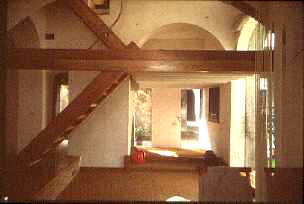
The Fornace degli Angioli
1972-75
Avenue Matignon
With the invitation to Paris to design the new headquarters of J.Walter Thompson in France, a very fruitful period opened up, with an activity in France that will last until 1992. The same and crucial relationship between modernity and the past, dug up to the core of the identity, which animates the urban plan of Milan, is expressed by the facade of the Avenue Matignon: a project that required a few years of gestation, having to overcome many obstacles until its completion in 1975. The façade then became very famous, published countless times, exhibited at the MOMA, but unfortunately, as a result of the renovation works of 2016, has been tampered with and betrayed.
Projects:
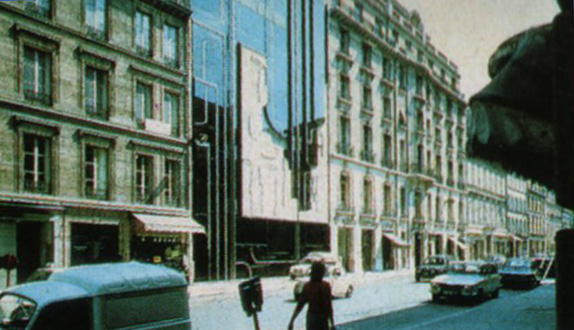
Avenue Matignon, Paris
The House
The third child was born, Lorenzo.
The old apartment was completely renovated, to become a beautiful two-storey house with two terraces and a new Angers slate roof brought from France. The house was so ready to give many other happy years to the family now full, until separation from May 1987 and subsequent sale.
Projects:
- Via Machiavelli 22, Milan
1976
Beginning of painting
Mazzucconi began to paint, just when, as an architect, he had reached maturity and maximum artistic mastery. It is as if, from this moment, he felt the need, as he himself says "to take consciousness also of the most secret and dark aspect of the personality, the shadow, and of integrating it with the rational, luminous part, which was expressed in architecture".
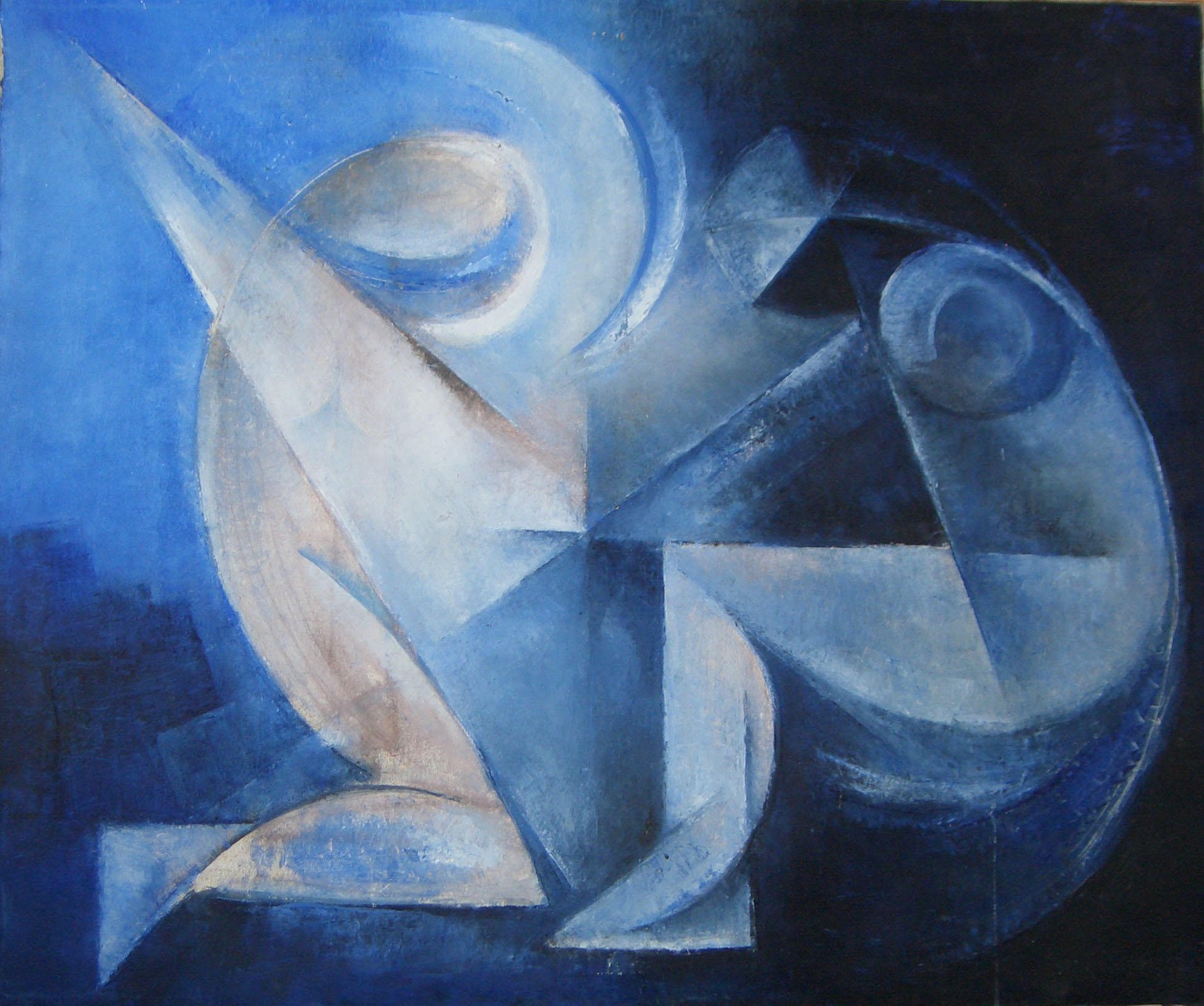
The spiritual work
Aix-Etoile
Perhaps the "Aix-Etoile" project for a new agglomeration near Paris responds to the same impulse. The architect imagines it as a true city, developed around its historical center of an ideal Roman footprint, whose orthogonal axes can be read, the forum, the walls, the temple. In doing so, it is as if he rediscovered a fundamental archetype, the city of the psyche, a model of inner healing from the aberration of the peripheries of our time.
Projects:
1977-80
The Lioran
The relationship is born with a magical place, the Lioran, the crater of the ancient Cantal volcano, in which Mazzucconi will build several buildings for some years. They show a spontaneous and profound relationship with nature, the same that he has with the soul and with the shadow. Thanks to it manages to ignore the cumbersome presence of a huge tower building next to which the village will rise.
Projects:
1978
The artist's mother dies. Almost in the same days he meets Brigitte, who becomes the inspiration for his painting. Especially after having left her the following year, he lives the intense pictorial season of the "Descent to the Underworld", new Orpheus in search of the lost Eurydice.
The projects of the great Ark of the "Halles" and of "The Ark of the Snows", of the same year, are born from the same inner journey and apocalyptic aura that had already inspired the first book of Mazzucconi. We will also feel its presence in the innumerable Arche projects of the following years.
In addition to the life of the soul that these works express, professional life also makes progress. The French Minister of Culture dispenses the "free" architect from the obligation of the degree, decreeing his enrollment in the “Ordre des architectes”.
1979-80
Projects:
- "The Ark of the Snows" (multi-functional center), Lioran, Cantal
- The Ark of the “Halles", Paris
- Painting: 50 paintings of the period "The Descent to the Underworld".
- Exhibitions: " Transformations on modern architecture", MOMA, New York;
- "Construire en quartier ancien", Grand Palais, Paris
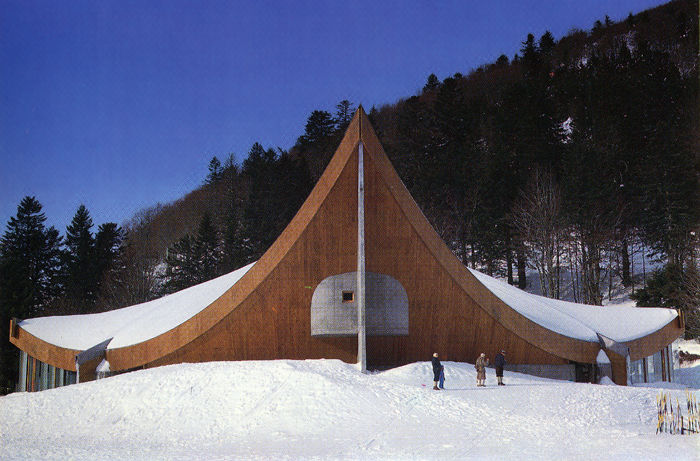
The Ark of the snows, Lioran (Cantal)
1981
The Citadel
He was appointed by the “Régie immobilière de la ville de Paris » to design the block Avenue d ' Italie -Rue du Tage -Rue de l'Industrie, in Paris. A project that he calls "La Citadelle" for a sense of defense from the brutal excesses of the 50s that have defaced the neighborhood. In order to neutralize one of these, the tower that unfortunately stands in the same are of the project, the tallest building of this has a mirror upper part that visually cancel the looming volume.
Projects:
- "The Citadel", Paris
- Painting: 15 paintings, begins the period "The night of the soul"
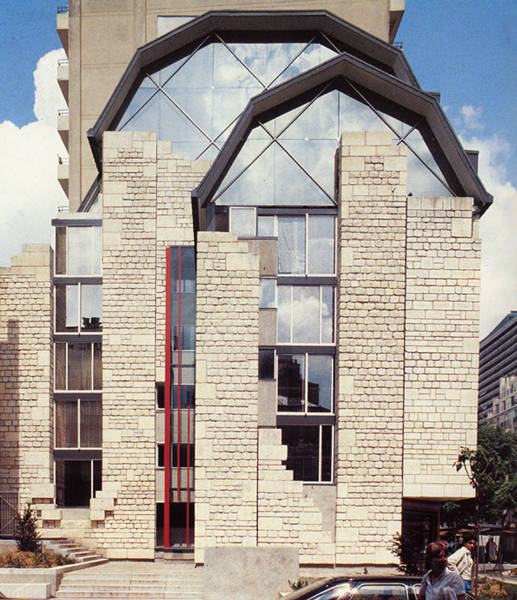
The Citadel, Paris
1982
Ministère des Finances
A project out of competition, since this was reserved for French architects, and also out of the program because it refused the imposition of the urban choice of a very long and low building. On the other hand, the project proposes a tall one that would have impressed a monumental sign in front of a large and free space like the Park of Bercy and the Seine. A tall building that would have allowed moreover an efficient vertical circulation instead of the horizontal one, extended irrationally to several hundred meters.
The proposed building is a mathematical object that presents itself differently according to the points of view.
Projects:
1982-83
The Arks of Paris
These are the years of participation in the great Parisian competitions, with which Mazzucconi proposes his " Arks ". He begin with the Arche des Halles (1980), the heart of the project presented at the Consultation des Halles: "morceau de roue gigantesque qui hante ce lieu d'une mémoire d'au-delà de la memoire historique ..., or qui est l’arche d'un Noé de la fin de notre monde", as Jean Maris Benoist writes . (1(3))
Follow the magic de l 'Arche des Neiges (1980), built in the wonderful landscape of Lioran
(Cantal ) and the project for the Center culturel Regional of St. Germain-en- Laye in which the same fundamental archetype is presented again in the small auditorium in the form of a cradle or an egg, inspired by the adjoining Chapel dedicated to the birth of the Roi soleil
In the Centre mondial de la Communication, Tete-Defense, Paris, the idea of a large inverted arch arises from a spontaneous complementarity with the roof of the adjoining building of the Knit , in order to rebalance the composition of the whole square. But it becomes much more, when its overthrow is put in relation with the Arc de Triomphe , certainly not with the intent of a political protest, but with that of a spontaneous inversion of worldly values in the name of the spiritual values that animates the whole work of Mazzucconi, from the Milan plan to many successive projects and all his books.
The project for the Opera - Bastille, Paris, and the one for the Parc de la Villette follow. In the latter he introduces the memory of the layout of the city walls, to be rebuilt in glass to make the greenhouses required by the program, and proposes the recovery of the Ark of the Halles, as a memorial of the sacrifice of the innumerable animals sacrificed in the slaughterhouse of the Villette.
Except for the first Halles project, which had aroused some interest, due also to the success of the Avenue Matignon building, all the projects for these competitions did not get any prize. They were not understood by a critical culture almost inexistent and however unaware of the spiritual values of which they were carriers.
Projects:
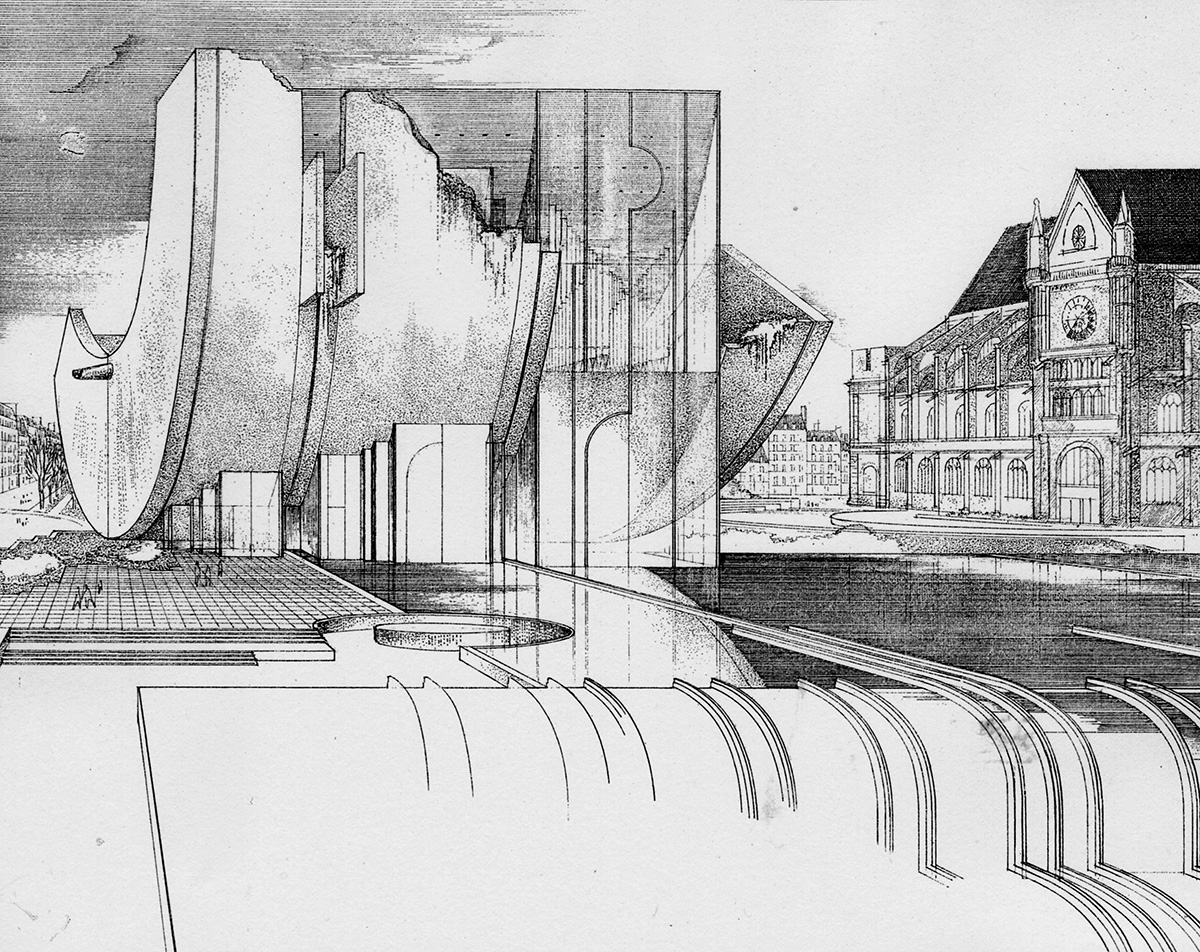
The Ark of the Halles, Paris
1983-84
The New Agora
In a life lived in the relationship with many cultures, sharing their identity, the meeting with Greece was not only important, but fruitful like a true love, as it has been for many men of culture over the centuries. Invited to Athens to design a new commercial center and offices with an international imprint, it has instead become for Mazzucconi a heartfelt act of love for classical Greece. Thus it was born The new Agora, inspired by the ancient Athens. Its porticos have returned, mindful of the Stoa of Attalos, the marble paved square, and even the temple, in a vision in which Mazzucconi once again experiences the unity of the themes of the re-foundation of the city, of the relationship between ancient and modern, and of the mysterious Ark that is identified here with the idea of a temple. It is the vision of an ideal Athens that will be realized for a whole decade in many buildings, but unfortunately built in today’s Athens, with many contaminations due to the materialistic frenzy of our time and local collaborations.
Nevertheless “not everything is just degradation," writes Bruno Zevi. "Mazzucconi, while he draws a high and noble portrait of modernity, intends to decode and animate the spirit of tradition through the interlocking play of pure volumes, reflecting surfaces, dematerialized columns, levitating technological sails, unstructured allusions.In dialogue with the genius loci and with the ingredients that articulate the code, nothing academic." (1)
Projects:
- The new Agora
- Amaleion Complex
- Project Akademia
- Painting: 15 paintings, continues the period of "Night of the soul"
- Exhibitions : Grands et jeunes d'aujourd'hui, Grand Palais, Paris
- One-man shows: Il Salice, Milan
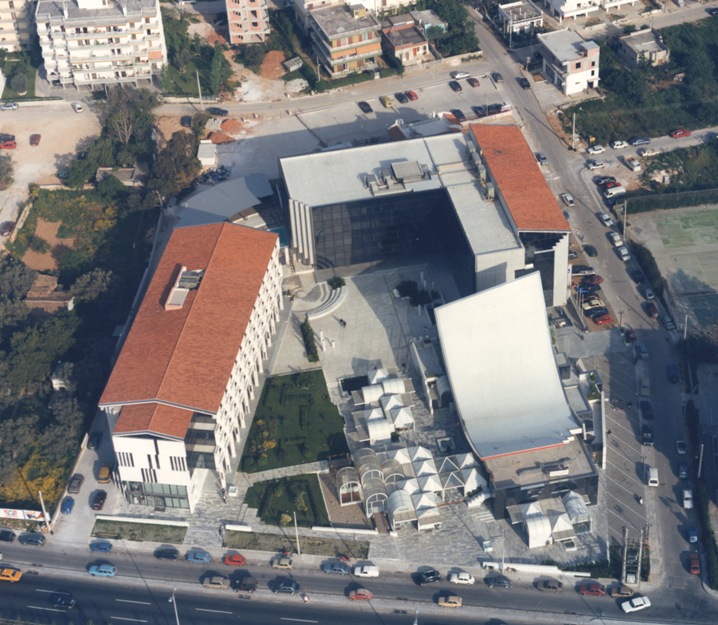
The New Agora, Athens
1985
The dawning city
Project for the new center of Florence. The book comes out with the same title, Edizioni Dedalo, at the conclusion of a long study on Florence that took many years, beginning in 1970. The book proposes the replacement of the nineteenth-century center of Florence, which still stands in the same area where the ancient Etruscan-Roman Florentia had been founded. Therefore, an undertaking that pushes its roots into the most remote past and at the same time opens a future with the proposal to create an international university campus in the rediscovered heart of the city.
The project is at the same time the esoteric map of the "city of the soul". The thistle and decumanus of the ancient Florentiaform intersecting the sign of the cross, which radiates from the sacral fossa with which, at the crossroads, the door of the Underworld opened. It can be seen in the the Flowerbuilding, built on the same crossroads, which houses a series of auditoriums covered by an elevated square divided into "petals". It makes one think of the near Cupolone as a closed bud, which instead opens in the Flower, bearing witness to the same sacredness that Agnoldomenico Pica rightly grasps. He writes that it "was rooted in Etruscan discipline and later translated into Christianity, guarded by the cathedral: a sacredness to which, today, has unfortunately abjured a society blinded and humiliated between the technological delirium or the vulgarity of the custom ". ( 1 )
Another building, the "Etruria Museum" , is made up of two superimposed pyramids: an underground one, destined to Etruscan art, and the other above, destined to the art of the Renaissance in which the Etruscan spirit lives again. The meaning of these projects and of the whole of the dawning city was then deepened and developed into a philosophy in other Mazzucconi books of the years 2012 and following.
Projects:
- "The dawning city", Florence
- Urban Plan of the Center of Florence "The flower", The Etruria Museum, The new Praetorium, The new Uffizi, Florence
- One-man shows: Studio Panigati , Milan
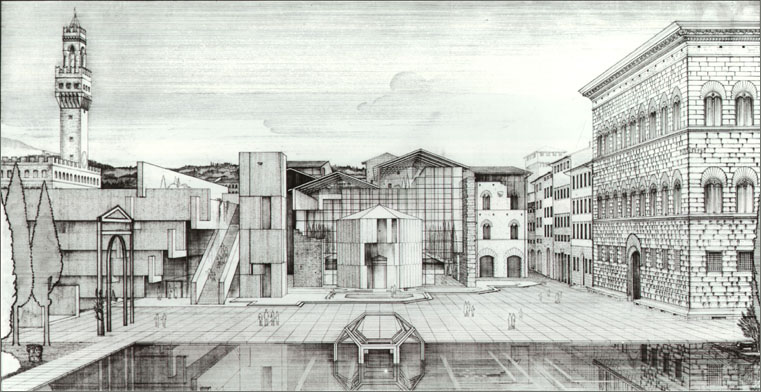
The Dawning City, Florence
1986
Stanislas-Meurthe
The project for the Canale area in Nancy ends in this year. It begun in 1978, initially commissioned by the French Ministry of Culture, before becoming later a competition, won by Mazzucconi. The city has a splendid historical center, built by King Stanislaus, next to which, however, the basin of a canal derived from the Meurthe , separates the center from the subsequent expansion of the city. The project intends to transform this gap into the opportunity for a new urban integration. It is part of it a large auditorium in which the Ark, Mazzucconi's central idea, appears as an interpretation of the nearby cathedral.
André Rossinot , Mayor of the city, canceled the outcome of the competition to entrust the task to Norman Foster, probably in search of easy publicity, but its project was not realized.
Projects:
- Urban plan of the Canal area, Nancy
- The Ark of the Cathedral, Nancy
- Shopping center in Psychico, Athens
1987
J.C. Decaux
After a first collaboration in 1980, this project was born for a plot on the corner between two streets, but not with the usual pan coupé typical of Paris but with a small square in which the dramatic evocation of an imaginary classical architecture, surmounted by the bow of a vessel. Jean-Marie Benoist rightly wrote that "Mazzucconi's work is that of a proliferating and symbolic creativity that never ceases to fulfill the richness of his enigmas and his ambiguities rigorously constructed ". ( 6)
Separation from May . Thus began a period of painful awareness but also of progressive interior liberation and pictorial momentum.
Projects:
1988-1993
Polis
With the project of the "Polis Center" and the headquarters of the "C.C.C." ( Consolidated Contractors Company) in Athens, the "neoclassical" inspiration of the "New Agora" continues. In the C.C.C. building the unusual solution of digging a small square inside its volume is born in order to avoid a discrepancy between the urban plan and the parcel which had been actually sold. The subsequent extension of the Polis Center along Kifissia Avenue is a work, imitative and unhappy, of other architects.
Other projects for Athens followed, but they were not realized.
Projects:
- Urban plan and buildings of the Polis I and II, sede del C.C.C. building, Villa Harlaftis; Russian complex; Houses in Nea Politia, Athens
- Competition for the Murate, Florence
- One-man shows: "The idea of the city" Anthology of architecture and painting, Palazzo Medici Riccardi, Florence; "The idea of the city", Kentro Technon , Athens; "L' idée de la ville", Hotel de Gallifet , Paris;
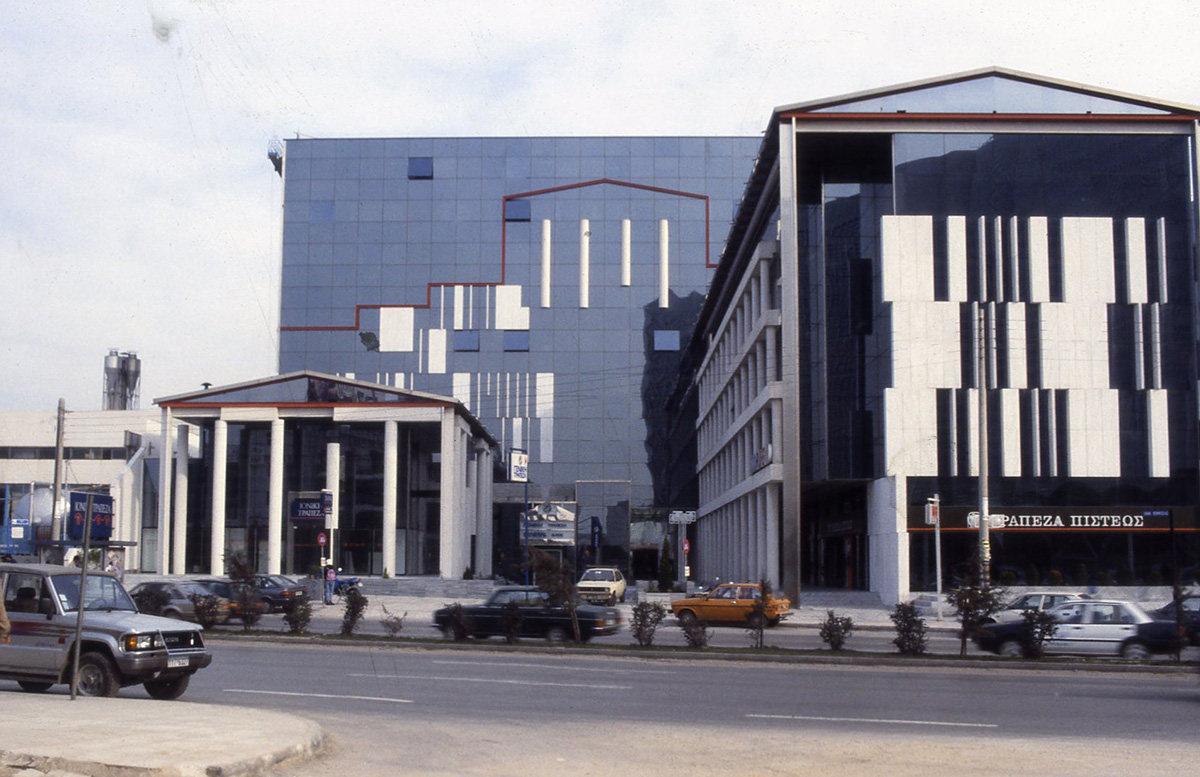
Polis Center, Athens
1989-1991
The new painting
After the various periods of painting of the previous years, that of the Descent to the Underworld (1979-80), that of the Night of the Soul (1981-86) with which the artist lives the dark sides of the soul, the following (1987-89) that is open to a richer psychological and artistic world, a new painting starts in a bright way wth a new love: Patrice, who,as a metaphora, makes us think of Proserpina. A love that was to stand only for a few months and end dramatically: that time, instead of an Orpheus in search of a lost Euridice, there was the crying of Demeter for the rape with which Pluto dragged Proserpina into the Hades.
A story that leaves its mark not only in large canvases but in the long meditation on the cyclicity of life and death with which the artist will become more and more a philosopher.(3) Part of this evolution is also the dialogue between the unconscious and the conscience that, for Mazzucconi, is reflected in that between painting and architecture.
It is also that between the shadow and the light, which is expressed in the last picture of this period, the Crucifixion.
Projects:
- One-man shows: Museo Remo Brindisi, Lido di Spina; Prisma Gallery, Verona; Galleria Friuli agli Scalzi, Venice; Sacred art in San Simpliciano, Milan; BPM , Bergamo, "The dawning city", Villa Era, Biella; Radice Gallery, Lissone; Le Colonne Gallery, Bologna; City Bank , Milan; Crucifixion in San Simpliciano, Milano
- Exhibitions: Grande Halle de la Villette, Paris ; Premio Fimis 90, Isola delle Femmine;
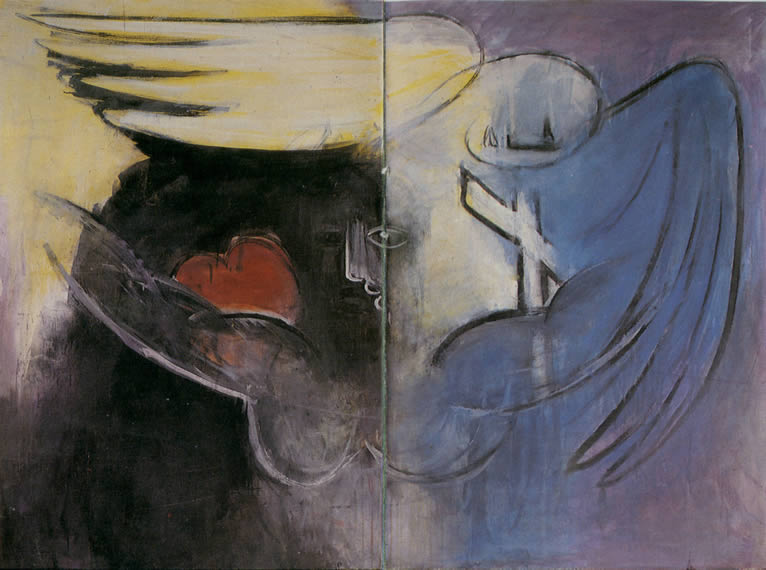
Crucifixion (detail)
1991-93
The Place of the Waterfall
In 1991 Vittorio Mazzucconi left the "Fornace degli Angioli " and moved to a new place, to which he gave the name "Il Luogo della Cascata" . There was in fact a small waterfall in the branch of the Naviglio that crossed the land which then became the beautiful garden of the new home-studio in which he transformed an old warehouse.
Mazzucconi finds the places of his life, as well as Via Machiavelli, the Fornace degli Angioli and others in which he builds his projects, in the true sense of the word "invenire" that is to discover, find, and ultimately invent. Places that are therefore his poetic creations, in the same way that they seem mysteriously predestined.
All this is unfortunately misunderstood by the countless people who have visited them and who continue to exclaim: "It does not seem to be in Milan ... but how did you find this wonder?"…pushing to imagine with some envy their cost. Mazzucconi explains that he would be happy to make their houses and the whole city happy and poetic, if he was in charge of it, but no one in Milan does so.
Il Luogo della Cascata is also the name of a Cultural Association, which runs a small publishing activity.
Projects:
- Renovation of the building in Via Andrea Ponti 1 , Milan (Il Luogo della Cascata)
- Marussi Town Hall; Polis III , Athens
- Painting: paintings of a new pictorial period, called "Stories" , of travels and meetings, serenely free from the deep involvement of previous loves.
- Exhibitions: Salon d'architecture , Triennale, Milan; "A point for Piero", Academy of Brera, Milan, Palazzo Ducale, Urbino, Italian School, New York; Artists in Pordenone, Pordenone
- One-man shows: Monte Campione Arte; Bpm , Bologna; Galleria 9 Colonne, Bergamo; Sant'Ambrogio Museum, Milan; Lyda Levi Gallery, Milan; Citifim , Treviso; Bpm , Milan; Citifim , Genova; Citifim , Turin; Gallera Osti 4, Milan; Galleria 9 Colonne, Piacenza
1993
Last competitions
Even without the professional support of his office, closed with the sale of the "Fornace degli Angioli " Mazzucconi participates in some competitions:
The project for a "Concert Hall" in Copenaghen, which has a composite character: it is linked to the form of the" Arkoften of the Snows"(1978) which is now mirrored in the water of the port as a real ship, combined with the quote of a Greek temple, which remind also the facades of many theaters.
The project for the “Spreeinsel” urban plan, in Berlin. The heart of this area was the Castle, home to the former palace of the Kaisers, which, after being damaged by the war, was razed to the ground to be replaced by a new government building of the GDR The program of the competition included the demolition of this last but not the question of how to replace it with a new architecture, since it was an exclusively urbanistic competition.
Mazzucconi instead centers his study on the Castle, proposing to reconstruct it, but not such and such, as was done in the following years, but as a memory, fragment or "ruin", to be included in a new architecture: an Ark carrying an ideal acropolis, like a catharsis with a strong symbolic meaning, located on the axis of Unter den Linden.
In this year also, with the occasion of a trip to India, a new great love was born: the one for Giuseppina, which will be happy and at the same time unhappy, because of the frequent contrasts that will eventually lead him to end almost six years later. The painting was the sensitive seismograph, recording the highs and lows in countless canvasses. As the artist says, "after the stories of Eurydice, lost in the underworld, and of Proserpina, which became the queen of the Hades, the story of Giuseppina makes me think of Psyche, who was deified by the love of Eros. In this experience human soul discovers together its complexity and its divinity".
Projects:
- Competition for a Concert Hall, Copenaghen
- Competition for "Spreeinsel", Berlino
- Painting: first paintings of the "Psyche" period
- One-man shows: Galleria Artestudio (2), Milan
1996-98
The Vittorio Mazzucconi Foundation
It began in 1996, with the aim of preserving Vittorio Mazzucconi's works and defending their ideals. The Foundation has organized many exhibitions of these works, donated to the Foundation, and those of other artists, as well as competitions and various events, which have been carried out in its wide spaces and in its garden.
In addition to these, Mazzucconi's work is in itself fundamental and giving. Many of his projects have been made without any compensation, like his paintings and books, a gratuity that has been accompanied by the poverty of their author and the fact that the Foundation has no profit, nor any patrimonial base outside the collection of his works.
Projects:
- One-man shows: "Art as an inner journey", "The Descent to the Underworld", "The paths of the soul", "The soul in painting", "The Golden Fleece", "The Spiral", "The Woman and the soul "," The invisible artist ", The Vittorio Mazzucconi Foundation, Milan
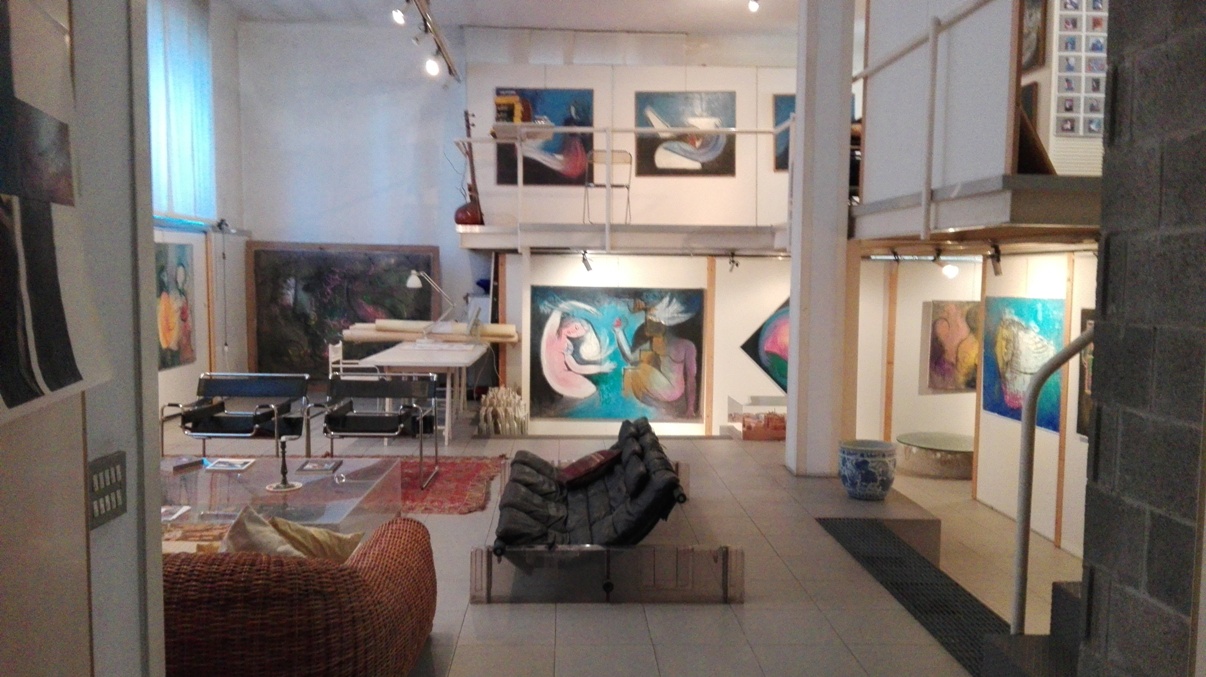
The Foundation
1999
The Citadel of Culture
It was a program launched by the Foundation to answer the question: " what is the function that art should perform today, to oppose the deterioration of the city and, more generally, of our time?
The program included an interdisciplinary workshop and an international competition of architecture and visual arts, having as its object a Museum of contemporary art, to be integrated into the Sempione Park, a cultural space that includes the Castle, the Arena and the Triennale. Participation was open to artists of all disciplines, ready to contribute to the future Museum with their works and their active commitment to make art an instrument for the creative transformation of the world.
"The essential theme to play was the man who, after having lived and witnessed to the end the drama of our time, recovers the spiritual center of his being".
Unfortunately, due to lack of sponsors , the program has not been implemented.

The Citadel of Culture Manifesto
2000-01
The Ark of Knowledge
UA project that was directed to this same purpose. In place of the large real estate program on the area of the former Porta Vittoria station, which only allocated an accessory part of it to the future Library (BEIC), Mazzucconi proposes a different layout of the buildings, in order to free the area along the Viale Umbria, to be underground in order to realize a continuity between the area and the facing Park of the “Marinai d’Italia”. The new Library could thus constitute the worthy protagonist of a magnificent space. As for the name and the meaning that Mazzucconi attributed to it, it was only a hope that unfortunately did not find any confirmation either in myopia of administrative decisions or in what should be a true knowledge.
After the end of Giuseppina's love, the artist painting expresses his pain with a series of works on paper and above all with the remaking of some great pictures of the happy years. Their idyllic representation was reversed with aggressive and sometimes brutal interventions that make them more intense and real.
In the same period he began a real estate business in association with his son Marco, who would go on for ten years with different residential projects, as Via Pestalozzi 10, to end up bankruptcy.
Projects:
- L'The Ark of Knowledge, Via Tolstoi, Via De Sanctis, Via Marghera, Viale Cassala, Via Pestalozzi, Via Zumbini, Alzaia Naviglio grande, Milan
- Painting: some paintings of 2004 (after years of interruption; they are also the last ones)
- One-man shows: "The repainted paintings", "The cards", "Computer art", "Last paintings 2004", "Art and Psyche", The Vittorio Mazzucconi Foundation, Milan
2007
The Palatine Pyramid
A project born from the intention of celebrating together the birth of Rome and her empire. Mazzucconi thus follows his idea of a necessary "refoundation" of the city, which he had already expressed in the urban plan of Milan, in the project " Aix-Etoile " and in that of the "Dawning City" for the new center of Florence. Since the new building should rise on the Palatine Hill, a land sacred to the city's memories, it is here that it takes the form of an "inverted" pyramid, which would thus rest on the archaeological ground only with its summit, so as not to contaminate it.
The building would house a museum and a university, with a large access space that would be obtained with the restoration of the ancient Stadium of the Imperial Palace. Other aspects of this Palace would be suggested by mirrors, thus creating a virtual palace, in subtle correspondence with the proportions of the ancient, designed by Rabirio. Another transformation would be carried by the large white marble sail generated by the pyramid, which would seem to push it, like a large ship, towards the East. It is in fact an Ark, that is a temple, which, like all temples, is oriented towards the rising sun. Also all the Arks of Mazzucconi have this orientation, which arises spontaneously as a sign of a spiritual intent.
Projects:
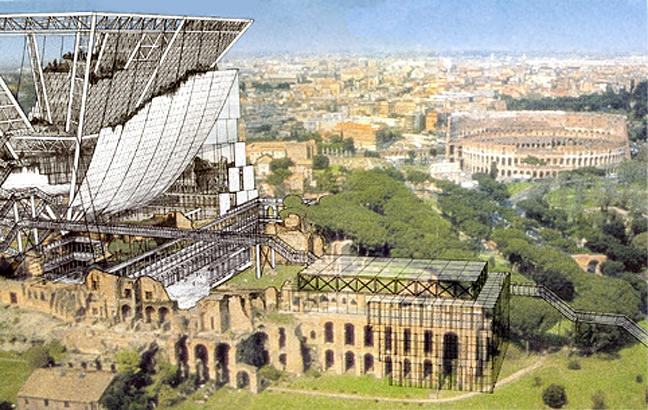
The Palatine Pyramid, Rome
2009
The Cathedral Ark
A project that is a distant fulfillment of the Milan Urban Plan of 1967. It proposed transforming the city center into a space for memories, culture and above all the education of young people: an "empty" space, that is, emptied of economic life, which could instead develop only in the area outside the Cinta dei Bastioni; in the center of this void the Cathedral.
The project now supports the Cathedral new "baptistery", to be built in front of it and the few underground ruins of the ancient, in which St. Ambrose baptized St. Augustine. A virtual baptistery, not confessional, with the meaning and the hope of a rebirth of the city and of man, perhaps after a tragedy similar to that of their time. It has the shape of an inverted pyramid, suggested not only by the previous one of the "Palatine Pyramid" but by the same shape of the triangular facade of the Cathedral; a form that is a symbol of spiritual openness, with the many implications that Mazzucconi explores in his books. The new building would also allow to give a better proportion to the huge square and to revitalize it with a decidedly contemporary intervention.
Projects:
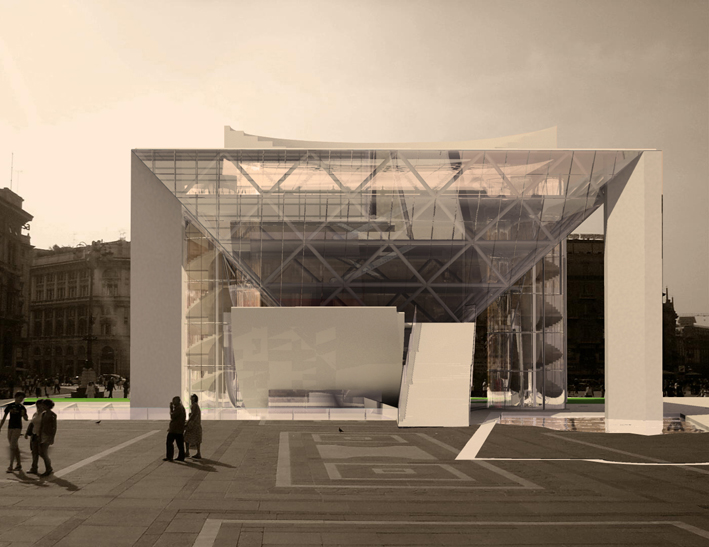
The Cathedral Ark , Milan
2009-12
The "Convivio"
It was a practice of philosophical dialogue that Mazzucconi has carried out for nine years with nine quarterly seminars and about one hundred meetings. Many people, participating in them, were confronted with the spontaneous and creative philosophy of the "guru", who invited them to find the truth in themselves.
The seminars meetings were: "The spiritual Work" , which deals with the re-foundation of the city and of man; "Art and Psyche" , which speaks of painting as an interior journey, through the eros; "Feelings and Reason", "Know Thyself", "Consciousness", "Knowledge and Love", "Harmony", "The Body and the Soul", "Being and Existing". After a first book - "Talking to Benedict" - started during a short stay in a Benedictine Monastery, the recordings of some of the seminars were subsequently published with the Edizioni Moretti & Vitali, and Mimesis.
2014-2021
To orientate oneself
It is the title of a series of the following and last books by Vittorio Mazzucconi (Edizioni del Luogo della Cascata, also as ebook, in italien ). The series did begin with "Il Viaggio, una vita, le opere e i pensieri " , which is his autobiography, and followed with "Il Ritorno a sé stesso”, "Lo Specchio interiore”, "La Sorgente", "L’Amico segreto”, "La Testa d'oro", "Il Testimone", "L'Uovo", “La Coscienza dell’anima”.
Books that are a continuous meditation, a continuous inner dialogue, through which the author's philosophy is outlined, in counterpoint with a reflection on his works of architecture and painting that, beyond their contingencies, reveal as many forms of the same thought .
This does not rely on the knowledge of philosophical opinions, nor on any artistic ideologies, but looks - says the author - "only to his own soul, to the nature that is her sister, and to the common Father".
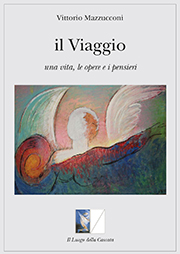
The Journey
2015-16
The body and the soul
It was an anthology of a selection of paintings by Vittorio Mazzucconi, organized by the Mudima Foundation in the space of the Mazzucconi Foundation, before it was subdivided and partly alienated.
The different rooms were dedicated to the following periods of this painting: an introductory room with the first paintings of 1976, a second one with the paintings of the "Descent to the Underworld" , a third with the period "The night of the soul" , a fourth dedicated to "Proserpina" , a fifth to "Psyche" , another to "Stories" and finally one dedicated to the last cards. An exhibition of books followed, whose covers reproduce some of the author’s paintings.
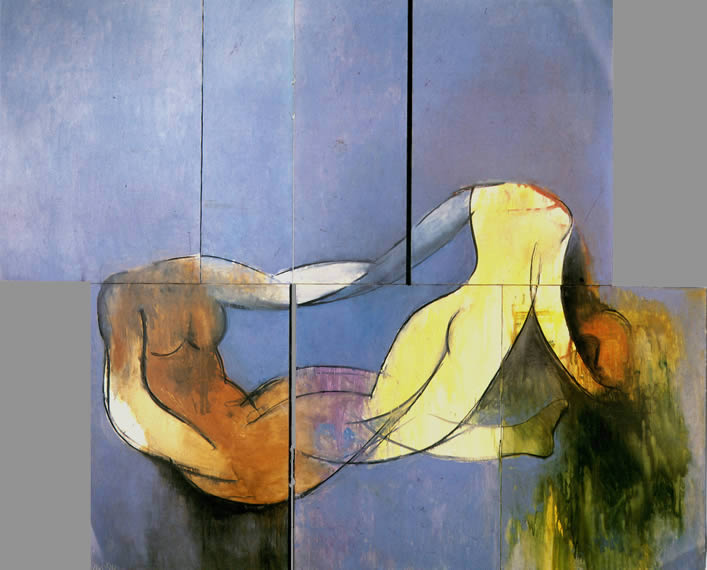
The body and the soul
2018
The Ark of Man
This is the title of the Mazzucconi Foundation's participation in the program "Il Novecento italiano" launched by the Municipality of Milan, a participation that has been divided into several meetings in which the themes of Vittorio Mazzucconi's work have been re-enacted: "The re-foundation of the city "," Architecture: a poetics for the city "," Painting: art as an interior journey "," Philosophy: Sophie "," To orientate: the reversal ", themes that show the possibility of following a different path from the failure to which the twentieth century led us.
It is a work of the last quarter of the century and a little more, which asks us to rewrite the history of the twentieth century, which is mostly concerned about false and ephemeral values.
A story that risks to be summarized in a catastrophe, to which Mazzucconi offers the salvation of the Ark: no more or not only "of the Duomo" but "of Man", the same idea that had begun fifty years earlier with "The City in the image and likeness of man " and that our children will perhaps realize.
Igor Jawlensky
Back to Index
|
